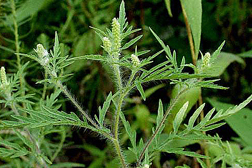This page has been archived and is being provided for reference purposes only. The page is no longer being updated, and therefore, links on the page may be invalid.
|
|
 Ragweed pollen. Photo courtesy of American Academy of Allergy, Asthma & Immunology. |
|
|
USDA Study Confirms Links Between Longer Ragweed Season and Climate Change
By Ann Perry
February 22, 2011
WASHINGTON—Studies by a U.S. Department of Agriculture (USDA) scientist and cooperators have confirmed what many pollen-sensitive people already suspected: In some parts of North America, ragweed season now lasts longer and ends later.
Ragweed pollen in some parts of the northern United States and Canada now lingers almost a month longer than it did in 1995, and these increases are correlated to seasonal warming shifts linked to climate change dynamics in the higher latitudes, according to a study published Monday in the Proceedings of the National Academy of Sciences.
"One of the biggest challenges in studying climate change is finding out how the plant kingdom is adapting to increases in air temperature and other meteorological phenomena," said Agricultural Research Service (ARS) Administrator Edward B. Knipling. "Studies like this also show us that these ecological shifts don't stop at crop production. They can also have a significant impact on public health."
ARS is USDA's principal intramural scientific research agency, and this research supports the USDA priority of responding to climate change.
Assessments by the Intergovernmental Panel on Climate Change suggest that current and future increases in land-surface temperatures are more likely to occur at higher elevations and at higher latitudes. But definitive studies correlating warming temperatures, longer growing seasons, and increased plant pollination have been lacking.
Lewis Ziska, a plant physiologist with the ARS Crop Systems and Global Change Research Unit in Beltsville, Md., led a scientific team that identified 10 locations that had at least 15 years of data, from 1995 to 2009, on local ragweed pollen counts. These locations were along a north-south transect from Austin, Texas, to Saskatoon, Canada. The researchers compared the pollen data at each site to other site data, including latitude, the number of frost-free days, and delays in the onset of the first fall frost.
The researchers found that from 1995 to 2009, the number of frost-free days at higher-latitude study sites had increased, and so had the length of the ragweed pollen season. During that period, the pollen season lasted from 13 to 27 days longer than in 1995. They also found that a longer ragweed pollen season was strongly correlated with a delay in the onset of the first fall frost.
Other collaborators included researchers from the Natural Resources Defense Council; the University of Massachusetts at Amherst.; the Allergy and Asthma Care Center in Fargo, N.D.; Allergy & Asthma Specialists in Minneapolis, Minn.; the Oklahoma Allergy and Asthma Clinic in Oklahoma City, Okla.; the Asthma and Allergy Center in Omaha, Neb.; the Hedberg Allergy and Asthma Center in Rogers, Ark.; Children's Mercy Hospitals and Clinics in Kansas City, Mo.; the Allergy, Asthma, and Immunology Clinic of Georgetown in Georgetown, Texas.; Allergy Associates of La Crosse, Wis.; the University of Wisconsin-Madison; Aerobiology Research Laboratories in Ontario, Canada; Rutgers University; and HealthEast Care System in St. Paul, Minn.

